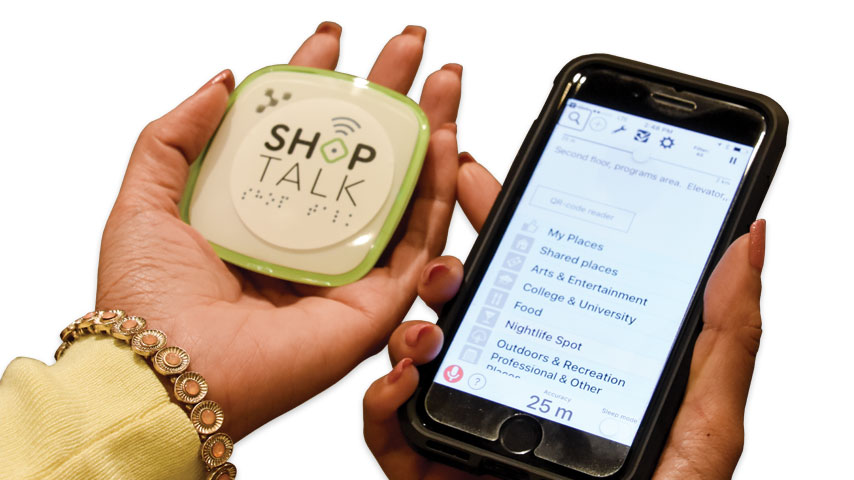Recently, I had the opportunity to visit Toronto and interact with our first beacon-accessible neighbourhood at Yonge and St. Clair. I’ve had the privilege of working on our accessibility initiatives during my time with CNIB, but I didn’t have the chance to experience our theories in practice until this week. I’m writing to you about my experience in case you’ve never had a chance to navigate with the assistance of beacons, to help give some perspective to the important work we’re doing.
 My guide dog and I exit a subway car in Toronto, entering a station completely unfamiliar to us. Through my headset, BlindSquare announces that I’ve reached the northbound platform at St. Clair Station, and offers me information about the location of various exits. As we orient ourselves and find a flight of stairs, BlindSquare provides additional information about the nearby construction. It tells me which doors lead to the streetcar drop-off, and which lead out to the street. As we exit the station and the GPS information becomes available, it tells me how far I am from the CNIB Toronto Community Hub. We approach an intersection, and it identifies the cross street. As I walk from the subway station to the hub, it tells me information about the businesses we’re passing. It tells me when we’ve reached the hub, and as we enter the building, it tells me information about the hub’s layout.
My guide dog and I exit a subway car in Toronto, entering a station completely unfamiliar to us. Through my headset, BlindSquare announces that I’ve reached the northbound platform at St. Clair Station, and offers me information about the location of various exits. As we orient ourselves and find a flight of stairs, BlindSquare provides additional information about the nearby construction. It tells me which doors lead to the streetcar drop-off, and which lead out to the street. As we exit the station and the GPS information becomes available, it tells me how far I am from the CNIB Toronto Community Hub. We approach an intersection, and it identifies the cross street. As I walk from the subway station to the hub, it tells me information about the businesses we’re passing. It tells me when we’ve reached the hub, and as we enter the building, it tells me information about the hub’s layout.
Until the adoption of technologies such as BlindSquare, most of the above information was only available through visual media such as signs or maps. Through tools such as GPS technology outdoors, and beacon technology indoors, BlindSquare makes this previously difficult to access information available audibly. The messaging activated by beacons is specially crafted to give me useful orientation information about the environment, allowing me to make autonomous choices and move about more safely and efficiently. The experience of navigating this route independently, in an area I’d never been to before, was particularly autonomous and efficient because of BlindSquare.
Accessible technologies like this are an important nexus point for CNIB, bringing together work by our accessible communities and accessible technology programs, the experience of orientation and mobility specialists, and many others. Understanding this technology and its applications is an important way for all of us to collaborate so everyone can travel where, when and how they choose.
-Ashley Shaw
Read more articles from the June 2019 issue of Equalize:
- Guide Dog AdvoCamp
- Protecting guide dogs' rights in schools
- CNIB Foundation Ontario “Know Your Rights” Project Update
- Debbie Gillespie bids farewell to CNIB
- Commitments to Accessibility and Inclusion in Federal Budget 2019
- Calling all advocates!
Equalize is published quarterly. Missed an issue? Catch up here!
Get the latest updates by following us on Facebook and Twitter.
